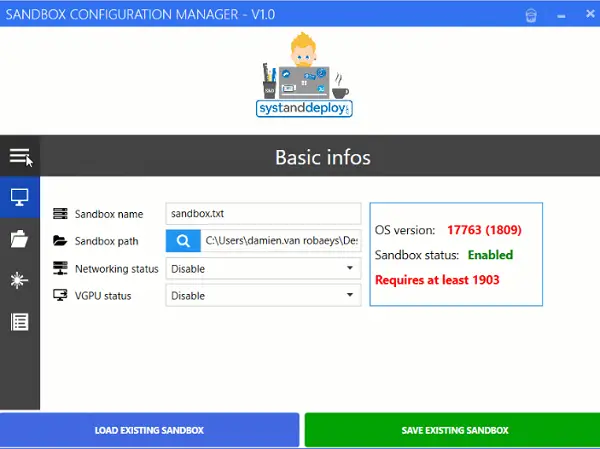Windows Sandbox is a lightweight desktop environment that makes sure that you can run applications in isolation. The arrangement makes sure the app doesn’t get access to core Windows files and other system files. That said, it’s not straightforward to configure & manage a sandbox. That’s where the Sandbox Configuration Manager can help you.
Sandbox Configuration Manager

Sandbox Configuration Manager allows you to generate, edit, and manage Windows Sandbox by using the configuration file aka WSB file. The tool offers four tabs:
- Basic Infos: It will enable you to Set Sandbox name, path, enable/disable networking and VGpu
- Mapped folders: It can share a new folder from the host computer, edit the existing and remove it.
- Command: Add/Remove/Edit existing startup commands.
- Overview: View the current configuration file.
To learn how to use it, follow this link where it is explained how to load a sandbox, manage mapped folders, use commands, and so on.
The configuration manager generates XML at the end, which is how Windows would have done.
Here is how to change basic info and Edit an existing folder; the rest you can check on their homepage.
Change basic Infos
- Go to the first tab > Type the name of the Sandbox to create
- Select the path of the new Sandbox and Use the Networking status ComboBox to set the networking tag
- Use the VPGU status ComboBox to set the VGpu tag
If the configuration is over, click on the Create Sandbox button
Edit an existing folder
- Go to the second tab
- In the DataGrid, click on the pencil button from the folder to change
- A dialogue will be displayed > Change what you want > Click on Save
Your changes will be applied in the Datagrid. If the configuration is over, click on the Create Sandbox button
It’s so good to see somebody coming out with an easy-to-use configuration manager for Sandbox that anyone can use. The instructions are easy to follow, and creating Sandbox is as easy as eating a pie. You can Download Sandbox Configuration Manager from TechNet Gallery.
Leave a Reply